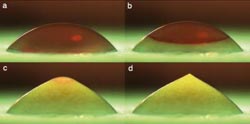Freezing water droplets form sharp ice peaks

A freezing front travels up a drop of water on a cold surface, forming a sharp point at the top.<br><br>Credit: Oscar R. Enríquez, Álvaro G. Marín, Koen G. Winkels, and Jacco H. Snoeijer, Physics of Fluids Group, University of Twente, Enschede, The Netherlands<br>
The photos are published in the American Institute of Physics' (AIP) journal Physics of Fluids. The approximately 4-millimeter diameter droplets took about 20 seconds to freeze. During the final stage of freezing, the ice drop developed a pointy tip, as can be seen in Figure 1d.
The effect, which is not observed for most other liquids, arises because water expands as it freezes. The vertical expansion of the ice, in combination with the confining effect of surface tension on the spherical cap of remaining liquid, leads to the point formation.
Once the liquid is completely frozen, the sharp tip of the drop attracts water vapor in the air, much like a sharp metal lightning rod attracts electrical charges. The water vapor collects on the tip and a tree of small ice crystals starts to grow, as seen in Figure 2. An opposite effect has been shown to preferentially extract water molecules from the sharp edge of potato wedges in the oven, the researchers note.
Article: “Freezing singularities in water drops” is published in Physics of Fluids.
Link: http://pof.aip.org/resource/1/phfle6/v24/i9/p091102_s1
Authors: Oscar R. Enríquez (1), Álvaro G. Marín (1), Koen G. Winkels (1), and Jacco H. Snoeijer (1)
(1) Physics of Fluids Group, Faculty of Science and Technology, MESA+ Institute, University of Twente, The Netherlands
Media Contact
More Information:
http://www.aip.orgAll latest news from the category: Physics and Astronomy
This area deals with the fundamental laws and building blocks of nature and how they interact, the properties and the behavior of matter, and research into space and time and their structures.
innovations-report provides in-depth reports and articles on subjects such as astrophysics, laser technologies, nuclear, quantum, particle and solid-state physics, nanotechnologies, planetary research and findings (Mars, Venus) and developments related to the Hubble Telescope.
Newest articles

Silicon Carbide Innovation Alliance to drive industrial-scale semiconductor work
Known for its ability to withstand extreme environments and high voltages, silicon carbide (SiC) is a semiconducting material made up of silicon and carbon atoms arranged into crystals that is…

New SPECT/CT technique shows impressive biomarker identification
…offers increased access for prostate cancer patients. A novel SPECT/CT acquisition method can accurately detect radiopharmaceutical biodistribution in a convenient manner for prostate cancer patients, opening the door for more…

How 3D printers can give robots a soft touch
Soft skin coverings and touch sensors have emerged as a promising feature for robots that are both safer and more intuitive for human interaction, but they are expensive and difficult…





















